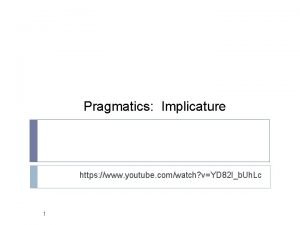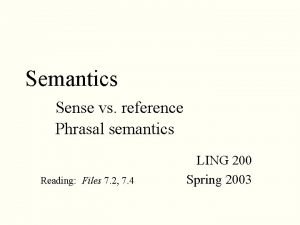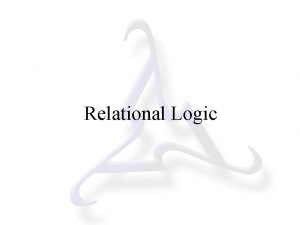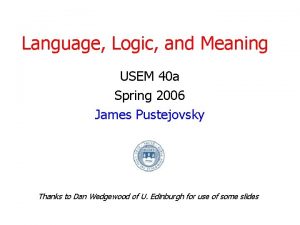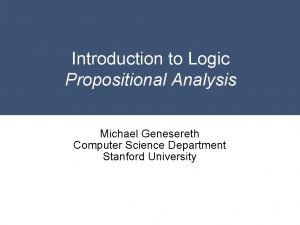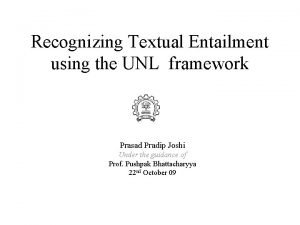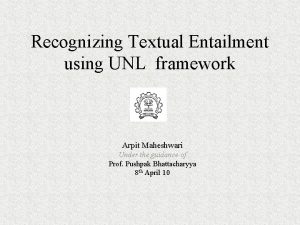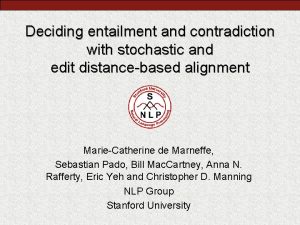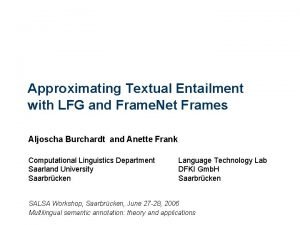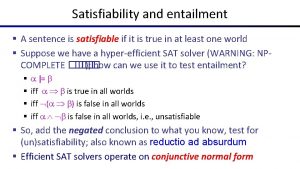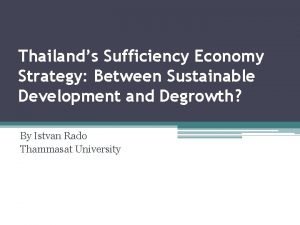Necessity entailment and sufficiency in a timeseries framework












































- Slides: 44

Necessity, entailment, and sufficiency in a time-series framework Some ontological assumptions of the econometric approach vs. the configurational approach

Researchers Wendy Olsen and Hisako Nomura With grateful thanks to D. Byrne l l Funding provided by Global Poverty Research Group www. grpg. org This study has had only a small amount of funding, and we hope to continue the empirical research later on. The study will be completed end June 2007. 2

Outline of the Talk l l 1 A Realist Approach to Causality 2 Entailment Vs. Interval Emergence and Other Conditional Claims Over Time 3 The Sufficiency of a Condition: What Commitments are Invoked When We Study X’s Sufficiency for Y Over Time? 4 Value-Related Ontological Commitments 3

1 Necessity (a Realist View) l l Iff X is a necessary condition for Y, then all instances of Y have X However X may be part of a combination that is in itself necessary for Y, and therefore X is not sufficient for Y It could be sufficient but that’s a different question We don’t like to assume that X and Y exhaust the nature of the social reality, hence evidence about instances of X and Y still leave us with fallibility of the conclusions (anti-empiricism) 4

Sufficiency l l l Iff X is sufficient for Y, then in all cases where X is observed, Y is also observed. This implies that X might cause Y. X causing Y would be a tendency that is not always observed. (Bhaskar, 1975, 1989) X could be an INUS condition for Y, i. e. part of a sufficient SET of causes, without in itself being sufficient for Y. We may not have observations on all of the items in the set. Furthermore, observed situations in which X consistently causes Y are not sufficient evidence forecasting forward about Y. This is due to new and intervening mechanisms. 5

Upcoming Related Theoretical Work l l ‘Interval emergence’ is the way that David Elder. Vass, a realist sociologist, is applying realist causality to change over time. An interval is a period of time. Emergence is the creation of new circumstances from the components and details of a current situation. Emergence has for too long been seen in purely theoretical, a-temporal terms. l l E. g. Divorce emerges from the crisis of marriage along with the institutions of marriage and the structures of gender. But a particular divorce emerges after certain events. 6

Ontology l An ontological assumption is an assertion that things exist in a certain way, and thus implies a theory of ‘being’ l l l Ontological assumptions in the Ragin framework typically force time into a single slice, i. e. crosssectional comparison Ontological work by H. Patomaki indicates that strategic moments are important and that path dependency implies that the future will not, in general, replicate the past. (JCR, 2006) Patomaki’s argument is more consistent with Skocpol’s comparative historical method. 7

What Ragin suggests is to balance the aims of generalization and intimate knowledge of a case by looking at limited numbers of cases. Instead of enforcing assumptions of homogenization on diverse units, he suggests recognizing diversity… It also implies that what may seem a population of homogeneous units is really a collection of diverse types of cases. Each of these different cases may be shaped by a particular pattern of causality. Ragin’s ontology allows his methodological choices and explanations to reflect the diversity of multiple causality and the varied attributes that define these different types. Levi-Faur, 2005: 11. (page number in typescript) 8

Ontological aspects of time l l l Time trajectories Feedback loops in cross-sectional diagrams correspond to path dependent shifts in the trajectory in a more longitudinal framework Sudden events, such as unique new events, create a new trajectory for some cases. These also combine with other factors. Recurring factors are likely to undergo change. Configurations help identify causalit(ies). 9

Configurationists Face Temporality 10

Causality as Referring to Real Causal Mechanisms, Not to Variables l l The realist approach argues that mechanisms can be real even if they don’t always have their effects. The transfactual reality of a causal mechanism X cannot be refuted by the absence of the corresponding outcome Y. l l (Sayer, 1984, rev ed. 1992, and 2000) Other factors may have intervened. 11

What is Realist About This? l l l A realist is not idealist. They do not form idealised or stylised views of how things develop. Yet a realist is also not a strong social constructivist. They argue that however we conceive of, or measure, the socio-political framework, it will still resist errors and tend to support ‘good’ rather than bad explanations. More than one explanation can be good. l (Pluralism: Olsen, Journ. Devt. Studies, 2006) 12

2 Entailment Vs. Interval Emergence and Other Conditional Claims Over Time l l 2 a)Is ‘Entailment’ A Useful Term? Suppose X was observed to cause Y over several decades in a repeated way. l l Example of school enrolment rates and overall attainment rates. Enrolment rate = the enrolled people ÷ the size of the relevant age group. Enrolment rates sometimes exceed 100%. Attainment rates = the number of years of formal schooling among the adult population, usually construed as those aged 16 -65. 13

An Example of Necessary and Sufficient Cause Over Time l l l There is good reason to care about the human development indicator ‘education’ with reference to the marginalised groups ‘girls and women’. (UNDP, Human Development Report annual) Enrolments in one period influence attainments in later periods. Strong evidence of necessity, but not sufficient relationship overall. ([X does not entail Y]) Looking at quadrants, we do find interesting deviations. Re-calibrating the data would lead to a fuzzy set analysis of consistency, and more causal factors. 14

References l Set theory shows that X is necessary for Y if the graph shows this shape (upper left quadrant empty): l l l Ragin, C. C. (2006). "Set Relations in Social Research: Evaluating Their Consistency and Coverage. " Political Analysis June 5, 2006 There is no evidence that high enrolments are sufficient for high attainments later on. We have checked 1972, 1982, 1992, 2002 with varying groups (M, F, all) and lags. 15

Enrolments Over Time – Their Effect on Attainments Vertical Axis: Formal School Attainment, Females, 15+, 2002 Sources: Barro data, online; UNESCO data, online Horizontal Axis – Primary Enrolments, Females, 1982. 16

2 b)Three examples to illustrate interval emergence l l l Botswana - the political decision to have compulsory schooling was a watershed event. Kenya – relatively lower attainment overall – but the political decision to have open access to all for higher education was a watershed event leading to very high enrolments. It was not possible to come through on the promises that were made, but these promises also had their own effects on expectations. India: a 1991 liberalisation has led to a huge growth in the quantity of private school, but not its quality 17

Botswana is a High Performer on Attainments Vertical Axis: Formal School Attainment, Females, 15+, 2002 Horizontal Axis – Primary Enrolments, Females, 1972. 18

Kenya was a Low Performer on Attainments But High on Enrolments Vertical Axis: Formal School Attainment, Females, 15+, 2002 it F st n io g Re L o t is at t S of l a c i ine e B f If you use statistics, you get large error terms for Kenya, Congo. Statistical methods require entailment. Horizontal Axis – Primary Enrolments, Females, 1982. . 19

Aside: One Could Study Marginal Changes Vertical Axis: Formal School Attainment, Females, 15+, 1992 to 2002 Horizontal Axis – Overall Enrolments, Females, 1992 to 2002 20

The idea that X entails Y is positivistic. Why would we, in general, want to search for a universal Entailment relationship over time? l Positivism is normally distinguished from empiricism using specific characteristics of the epistemology and the ontology. l Epistemology: empiricism has data=reality, as does positivism. But empiricism has data revealing differences, e. g. allowing induction to take place, whereas positivism is deductivist. The nomothetic modelling approaches are the really positivist ones, whilst ordinary statistical ‘operationalisation’ is not necessarily positivist. Ontologically, positivism assumes laws can and do match up with nature, whereas empiricism focuses on evidence itself and is agnostic about the nature of reality. Here, positivism shows signs of naïve realism. Critical realism and scientific realism do not suffer from this weakness, and these authors prefer QCA over statistical methods. Examples include Byrne, Kent, Lawson, and Sayer. Numerous critical realists have rejected the use of statistics. l 21

3) The Sufficiency of a Condition: What Commitments are Invoked When We Study X’s Sufficiency for Y Over Time? l l l 3 a) Econometric approach: you have a model and its parameters. The model is the same over time, but the parameters are allowed to change. Furthermore, the parameter for a dummy variable can control for the intervening factor that arises freshly at a point in time. After ‘controlling’ for this factor (as an additive factor; see Abbott; see Mukherjee), you are still testing for whether X is both Nec’y and Suff’t for Y overall This modelling ‘overall’ is very universalistic and includes a time-independent causality 22

3 b)Does a cohort effect improve the statistical approach? l l In statistics, you can have age, cohort- [also known as generational], and year effects. Age effects are measures across time periods, under the assumption that humans are responding in lawlike ways across the whole time period, e. g. 19602000 Cohort effects are those specific to a particular generation (of humans) or a specific group of countries (if countries are the cases concerned) Year effects are the residual time trend which lacks a causal explanation. (By controlling for time this way, the economists reduce their ‘error’ term considerably, yet don’t have any explanation!) 23

Reference l Winship, C. and D. J. Harding (2004). A General Strategy for the Identification of Age, Period, and Cohort Models: A Mechanism Based Approach. Paper, American Sociological Association, 2003. Atlanta (Paper name, 'The Analysis of Over-Determined Outcomes'). 24

3 c)Cohort Effects are Universalistic Over Space l l Check this: “Cohort effects are those specific to a particular generation” There is a universal law-like modelling underneath the details of the cohort effect estimates This universalism is a form of positivism. It is surprising to find it surviving in the present age. 25

Ragin’s superior approach l l In Ragin’s approach, it appears that time is squeezed into a single moment But this is also a way to allow each country to be unique, and each configuration to appear from within the whole set of characteristics of the country including its trajectory over time Hence the idea of cluster-analysis of the whole set of time-dependent variables, combined with QCA for a main Outcome against the Clusters, makes sense. Critically, we do not make generalisations outside of the cases for which there are data! 26

Has Ragin at Times Conceded Too Much to Positivism? Social research tends to be either intensive or extensive. Intensive research. . . does not offer powerful tools for constructing generalizations, testing theories, or making broad predictions. These latter tasks are better served by the variable-oriented strategy, an approach that focuses on the covariation between two or more phenomena across many observations. This latter strategy is a powerful data condenser; generality is its forte. Ragin, Shulman, Weinberg and Gran, 2003: 324. Are these authors allowing for extensive research to generalise across the cases, or beyond the available data? In other words is extensive research going to make supportable predictions outside its sampling area? A post-positivist would suggest that generalizations must refer to particular populations, geographic and time boundaries. Predictions are withinsample even when inference is used; random sampling is just a cost-saving device. 27

4 Ontological Commitments of Those who Study Causality Over Time l 4 a) how reality is conceived -- On the Realist Side: l l Diversity, organic self-transformation of interlinked open systems Heterogeneity and real change inevitably produce. . . Complexity Not just trivial complexity but real complexity (Byrne) On the Econometric Side: l l Lags, an assumption of homogeneous causes but lag-length as a parameterised ‘unknown’ Homogeneity of cases Universality of causal models Diversity of parameter values in particular instances, notably allowing the parameters to change over time. (often modelled as an interaction of the parameter with the time variable) 28

Laws or Not Laws? l l l On the Realist Side l There are some laws in nature but there are none in society l All causal mechanisms work in tandem (in conjunction) l Since society affects nature and vice versa, laws are not something we should be seeking at all in science l But looking for causal mechanisms is still worthwhile, and has practical implications l The generalisation of results within sub-groups is interesting solid knowledge of a detailed kind The generalisation of results externally to wider populations is likely to be fraught due to unique events We seek to use retroduction to explore why and how things have happened 29

l On the econometric side, l l l Laws are thought to be parsimonious representations of basic causal mechanisms This word ‘basic’ implies universally similar causal processes The ontic units being referred to have lots of underlying homogeneity Example of FDI, Trade, Inv’t, Output, Growth And Education, LFP, Growth [of countries] 30

31

Causal Model Women High% Prof-Mangt Girls’ Schooling Women’s Educ’n LFP of Women Economic Growth The benefits of women’s labour force participation (LFP) are many. It is widely agreed (e. g. ILO, Millenium Development Goals, Lisbon Declaration of the EU) that raising LFP of women raises women’s opportunities for autonomy and empowerment. It also upwardly influences the economic growth rates. 32

What are we looking for? l l l Realists: Difference. Method of iterative case choice – Levi-Faur Study of historical change – Leys Moral engagement Necessary but NOT sufficient causes, or vice versa! Qualitative knowledge not just evidence l l l Econometricians: Similarity. Method of ignoring outliers – China Study of change only since the Bretton Woods Order began 1947 – IMF Impersonal (pretense) Black-Box approach to statistics The ‘error’ is measured as greater in non-dominant configuration 33

4 b)Further Development of The Example l l l Do higher girls’ enrolments necessarily entail higher economic growth rates later on? ENROLF ATTAINF And ATTAINF LFP of women And LFP of women GROWTH These results were established using statistical methods and are widely believed stylized facts 34

Intervening Factors (see Patomaki on ‘Future Studies’, JCR, 2006) l l Girls join the labour force, but also many of them drop out at the time of marriage or first baby. The statistical evidence is strengthened by the delaying of first-birth to later ages. Capturing this delay is hard because there is real diversity and heterogeneity in gender roles and how mothers are treated By welfare systems; by families 35

A list of intervening events l l Housewifisation (Mies, 1989); Growing social status of having an educated wife, independent of her earning status; Structural change away from women’s garment industries and other ‘nimble fingers’ work toward ‘skilled work’; Profound transport difficulties combined with harassment of women in public in some configurations 36

So the law is broken? l l l The econometric or statistical positivist method would have to conclude that the law has been broken, is breaking down, or is subject to other intervening laws As soon as this is admitted, however, the empiricist grasp of tabulated data as proof of causes is weakened Instead the qualitative arguments and theories have to be found convincing 37

Retroduction Over Time l l l We can take a country with a high or rising housewife component in urban areas, and study events that caused people there to value housewifisation so highly Ask why it happened that way there (e. g. Japan, but not China) Reframe the causal process, such as “confucianism” or “patriarchy”, in more detail l l Do the same with the achievement of high attainments Either requires historical and sociological detail as our case studies illustrate Asking ‘why’ is the basic technique of retroduction Textbooks by Danermark, et al. , and the edited volume by Cater and New explain the importance of seeing research as fundamentally qualitative 38

4 c) Value-Laden Ontological Commitments – i) being responsive to local categories. l l In QCA, we begin and iterate data-recording with qualitative enquiry. The qualitative enquiry is theoretically rich, innovative, open -ended (i. e. willing to change the discourse in response to evidence), and responsive to human needs In QCA, there is a stage which involves truthtable reduction and some calculations, but this is not just a ‘black-box’ technique. We advocate QCA as part of a methodology, not just as a technique. 39

Value-Laden Ontological Commitments – ii) The values of theoretical frameworks are substantive l l l Lacey argues that theoretical framework within which a study is set up invokes valueorientations (Va), is strategic, and offers an initial moral presupposition for the research. Va Data collection Data analysis Policy Vconc 40

Lacey says data analysis can be done relatively impartially, but is not in itself value-independent because it is done underneath the presumptions of Va. QCA truth tables lie in Stage 2. l Stage 1 l Va l Stage 2 Stage 3 Data collection & Data analysis Policy Vconc 41

Value-orientation – iii) an example in the study of Education in Capitalism l l l My interest in education rests upon the idea that learning and skills are a desirable human capability (Nussbaum), and that formal schooling is a way that the upper classes distinguish themselves and exclude workers from high positions in society Therefore I can construct a study of Education in India by Social Class, by Gender, by Occupation This creates panel data for each social class over time (1989, 1994, 1999, 2004) 42

Conclusions l l l The argument has been that a realist approach to methodology is consistent with QCA, but defines QCA as much more than a black-box truth-table calculational tool. In this context, ‘entailment’ (forward sufficiency of a cause X for an outcome Y) is not that interesting, for methodological reasons Predicting wouldn’t be valued as much as understanding how each configuration works to produce outcome Y or y 43

l l l However, interval emergence and other conceptualisations that identify strategic turning points and the events that remove real barriers to progress can be interesting areas for further research. In this way, QCA supports profoundly qualitative research. Books making consistent arguments include Flyvberg, Making Social Science Matter (2001). 44
 Background and foreground entailment
Background and foreground entailment Gwpy timeseries
Gwpy timeseries Darts timeseries
Darts timeseries Matlab timeseries get value at time
Matlab timeseries get value at time Neocolonialism definition ap human geography
Neocolonialism definition ap human geography Sufficiency economy
Sufficiency economy Oklahoma rsa screeners
Oklahoma rsa screeners Objective of physical education
Objective of physical education Resource sufficiency feasibility analysis
Resource sufficiency feasibility analysis Physical spheres
Physical spheres Lifeworks self sufficiency matrix
Lifeworks self sufficiency matrix Entailment vs implicature
Entailment vs implicature Presupposition and entailment
Presupposition and entailment Example of presupposition
Example of presupposition Obligation necessity and permission
Obligation necessity and permission Necessity, advisability, and expectations.
Necessity, advisability, and expectations. Possibility and ability
Possibility and ability Semantic exercise meaning
Semantic exercise meaning To kill a mockingbird vocabulary
To kill a mockingbird vocabulary Entailment vs implicature
Entailment vs implicature Inference vs entailment
Inference vs entailment Entailment observasi
Entailment observasi Sense vs reference
Sense vs reference Prop logic
Prop logic Entailment in semantics
Entailment in semantics Logical entailment examples
Logical entailment examples Police necessity
Police necessity Explain the necessity of irrigation
Explain the necessity of irrigation Necessity of fuse
Necessity of fuse Sebutkan tipe-tipe wirausahawan menurut ir. ciputra
Sebutkan tipe-tipe wirausahawan menurut ir. ciputra What year did george washington attacks ft necessity
What year did george washington attacks ft necessity Business necessity definition
Business necessity definition Larry and peggy are making decisions
Larry and peggy are making decisions Netiquette
Netiquette Dol starter working
Dol starter working May can
May can Conceptual and theoretical framework example
Conceptual and theoretical framework example Dispositional framework vs regulatory framework
Dispositional framework vs regulatory framework Drawing a conceptual framework
Drawing a conceptual framework Theoretical framework
Theoretical framework Dispositional framework vs regulatory framework
Dispositional framework vs regulatory framework Conceptual framework vs theoretical framework
Conceptual framework vs theoretical framework Performance and development framework
Performance and development framework Literacy numeracy framework
Literacy numeracy framework Translations between user and system
Translations between user and system



















